Mechanisms associated with tolerance to flooding during germination and early seedling growth in rice (Oryza sativa)
- PMID: 19001425
- PMCID: PMC2707318
- DOI: 10.1093/aob/mcn211
Mechanisms associated with tolerance to flooding during germination and early seedling growth in rice (Oryza sativa)
Abstract
Background and aims: Flooding slows seed germination, imposes fatalities and delays seedling establishment in direct-seeded rice. This study describes responses of contrasting rice genotypes subjected to flooding or low oxygen stress during germination and discusses the basis of tolerance shown by certain cultivars.
Methods: In one set of experiments, dry seeds were sown in soil and either watered normally or flooded with 10 cm of water. Seedling survival and shoot and root growth were assessed and seed portions of germinating seedlings were assayed for soluble sugars and starch concentrations. The whole germinating seedlings were assayed for amylase and peroxidase activities and for ethylene production. Activities of enzymes associated with anaerobic respiration were examined and gene expression was analysed separately with seeds germinating under different amounts of dissolved oxygen in dilute agar.
Key results: Flooding during germination reduced survival but to a lesser extent in tolerant genotypes. Starch concentration in germinating seeds decreased while sugar concentration increased under flooding, but more so in tolerant genotypes. Amylase activity correlated positively with elongation (r = 0.85 for shoot and 0.83 for root length) and with plant survival (r = 0.92). Tolerant genotypes had higher amylase activity and higher RAmy3D gene expression. Ethylene was not detected in seeds within 2 d after sowing, but increased thereafter, with a greater increase in tolerant genotypes starting 3 d after sowing. Peroxidase activity was higher in germinating seeds of sensitive genotypes and correlated negatively with survival.
Conclusions: Under low oxygen stress, tolerant genotypes germinate, grow faster and more seedlings survive. They maintain their ability to use stored starch reserves through higher amylase activity and anaerobic respiration, have higher rates of ethylene production and lower peroxidase activity as germinating seeds and as seedlings. Relevance of these traits to tolerance of flooding during germination and early growth is discussed.
Figures
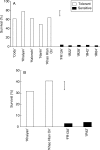

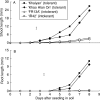
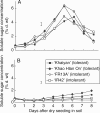


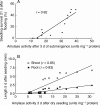
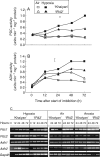

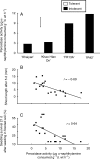

Similar articles
-
Responses of AG1 and AG2 QTL introgression lines and seed pre-treatment on growth and physiological processes during anaerobic germination of rice under flooding.Sci Rep. 2020 Jun 23;10(1):10214. doi: 10.1038/s41598-020-67240-x. Sci Rep. 2020. PMID: 32576897 Free PMC article.
-
Adaptation to flooding in upland and lowland ecotypes of Cyperus rotundus, a troublesome sedge weed of rice: tuber morphology and carbohydrate metabolism.Ann Bot. 2009 Jan;103(2):295-302. doi: 10.1093/aob/mcn085. Epub 2008 May 30. Ann Bot. 2009. PMID: 18515404 Free PMC article.
-
Amylolytic activity and carbohydrate levels in relation to coleoptile anoxic elongation in Oryza sativa genotypes.J Plant Res. 2013 Nov;126(6):787-94. doi: 10.1007/s10265-013-0567-1. Epub 2013 Jun 8. J Plant Res. 2013. PMID: 23748354
-
Rice germination and seedling growth in the absence of oxygen.Ann Bot. 2009 Jan;103(2):181-96. doi: 10.1093/aob/mcn121. Epub 2008 Jul 25. Ann Bot. 2009. PMID: 18660495 Free PMC article. Review.
-
Metabolic adaptation to sugar/O2 deficiency for anaerobic germination and seedling growth in rice.Plant Cell Environ. 2014 Oct;37(10):2234-44. doi: 10.1111/pce.12311. Epub 2014 Apr 9. Plant Cell Environ. 2014. PMID: 24575721 Review.
Cited by
-
Seed pre-treatment in rice reduces damage, enhances carbohydrate mobilization and improves emergence and seedling establishment under flooded conditions.AoB Plants. 2011;2011:plr007. doi: 10.1093/aobpla/plr007. Epub 2011 Feb 18. AoB Plants. 2011. PMID: 22476478 Free PMC article.
-
Tolerance of anaerobic conditions caused by flooding during germination and early growth in rice (Oryza sativa L.).Front Plant Sci. 2013 Jul 23;4:269. doi: 10.3389/fpls.2013.00269. eCollection 2013. Front Plant Sci. 2013. PMID: 23888162 Free PMC article.
-
Examination of two lowland rice cultivars reveals that gibberellin-dependent early response to submergence is not necessarily mediated by ethylene.Plant Signal Behav. 2011 Jan;6(1):134-6. doi: 10.4161/psb.6.1.14268. Epub 2011 Jan 1. Plant Signal Behav. 2011. PMID: 21224726 Free PMC article.
-
Transcriptional and Metabolic Changes Associated with Phytoglobin Expression during Germination of Barley Seeds.Int J Mol Sci. 2020 Apr 17;21(8):2796. doi: 10.3390/ijms21082796. Int J Mol Sci. 2020. PMID: 32316536 Free PMC article.
-
Preferential Geographic Distribution Pattern of Abiotic Stress Tolerant Rice.Rice (N Y). 2018 Feb 8;11(1):10. doi: 10.1186/s12284-018-0202-9. Rice (N Y). 2018. PMID: 29423779 Free PMC article. Review.
References
-
- Atwell BJ, Greenway H. Carbohydrate metabolism of rice seedlings grown in oxygen-deficient solution. Journal of Experimental Botany. 1987;38:466–478.
-
- Avadhani PN, Greenway H, Lefroy R, Prior L. Alcoholic fermentation and malate metabolism in rice germinating at low oxygen concentrations. Australian Journal of Plant Physiology. 1978;5:15–25.
-
- Beck E, Zeigler P. Biosynthesis and degradation of starch in higher plants. Annual Review of Plant Physiology and Plant Molecular Biology. 1989;40:95–117.
Publication types
MeSH terms
Substances
LinkOut - more resources
Full Text Sources
Other Literature Sources
Medical

